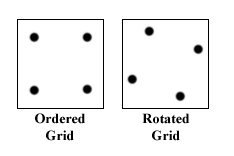Image Quality Analysis Fall 2003: A Glance Through the Looking Glass
by Derek Wilson on December 10, 2003 11:14 PM EST- Posted in
- GPUs
Antialiasing
Non-horizontal and non-vertical straight lines and edges need to be approximated via multiple small horizontal or vertical lines. This is due to the fact that pixels on the screen are laid out in a grid. The resulting problem is called aliasing and it can bee seen as jagged edges in an image.To combat this, supersample antialiasing was created. The principle behind this is that a larger resolution image is generated for each scene. This larger image is then downsampled and filtered. Of course, generating this image is very expensive, and to combat the performance hit, multisample antialiasing was devised.
Multisample antialiasing works on the same principal as supersample without having to generate the image at a larger resolution. The idea is to generate multiple, slightly-shifted versions of each pixel at the same time for use in the filtering process. The level of antialiasing has to do with the number of pixels generated (subsamples) to calculate the final pixel color value.
The differences in image quality come in when we look at what subsamples are generated for each pixel. Generating subsamples that form a square with horizontal and vertical edges within each pixel means we are using a method called ordered grid antialiasing. This doesn't lend itself to smoothing very close to horizontal or very close to vertical edges. To address such edges, we can slightly rotate or skew the square in order (giving us the rotated grid antialiasing scheme).
 |
| The squares represent pixels while the dots within are multisample subsamples. |
As it happens, ATI uses a rotated grid antialiasing, while NVIDIA sticks with ordered. This creates a lot of room for variation between the cards antialiased images.










35 Comments
View All Comments
retrospooty - Thursday, December 11, 2003 - link
I have been visiting Anandtech for well over 4 years , and I have often exclaimed how thorough, fair, and unbiased this site is to others...This is the first article I have ever read here that I think is complete poop. I cannot beleive that in any fair IQ test Nvidia came anywhere close to ATI. Either the author is not being honest, or is color blind. Anyone with eyeballls can compare the two and see that ATI is much sharper, and vibrant especially with AA... Nvidia is WAY blurry.
I am very VERY dissapointed in this. :(
TheGoldenMenkey - Thursday, December 11, 2003 - link
Excellent article. I would much rather be taught why things are different than be showed some differences in rendering and then have someone declare which one is cheating. Thanks for teaching us enough to let us come to our own conclusions. Keep up the good work AT.tazdevl - Thursday, December 11, 2003 - link
Better look @ that... then we might have something to discusshttp://www.anandtech.com/video/showdoc.html?i=1931...
dvinnen - Thursday, December 11, 2003 - link
Artical seemed fair and unbias to me. Your AA and AF question is odvious. Look at the URL of the png file. It clearly states what is on.It seems they have cleaned up there DX9 proformance, but they still treat synthitic benchmarks badly. Most recintly the 3DMark03 patch a month ago and how they handeled the media (PR on one side of the pond said one thing, on the other saide, they said another)
tazdevl - Thursday, December 11, 2003 - link
So Derek to you own stock in nVIDIA? Did Brian Burke write this for you?Were AA and Aniso used in all tests or a few? Which ones? What modes are we comparing against which benchmarks?
Ever thought that BOTH nVIDIA and ATI can fix the outstanding instead of just nVIDIA?
I swear, every since Anand got caught up in the whole NV30 fiasco, the site's credibility is worth absolutely squat when it comes to nVIDIA.
I'm not saying ATI is without faults, but let's try to appear unbiased at a minimum in the article.